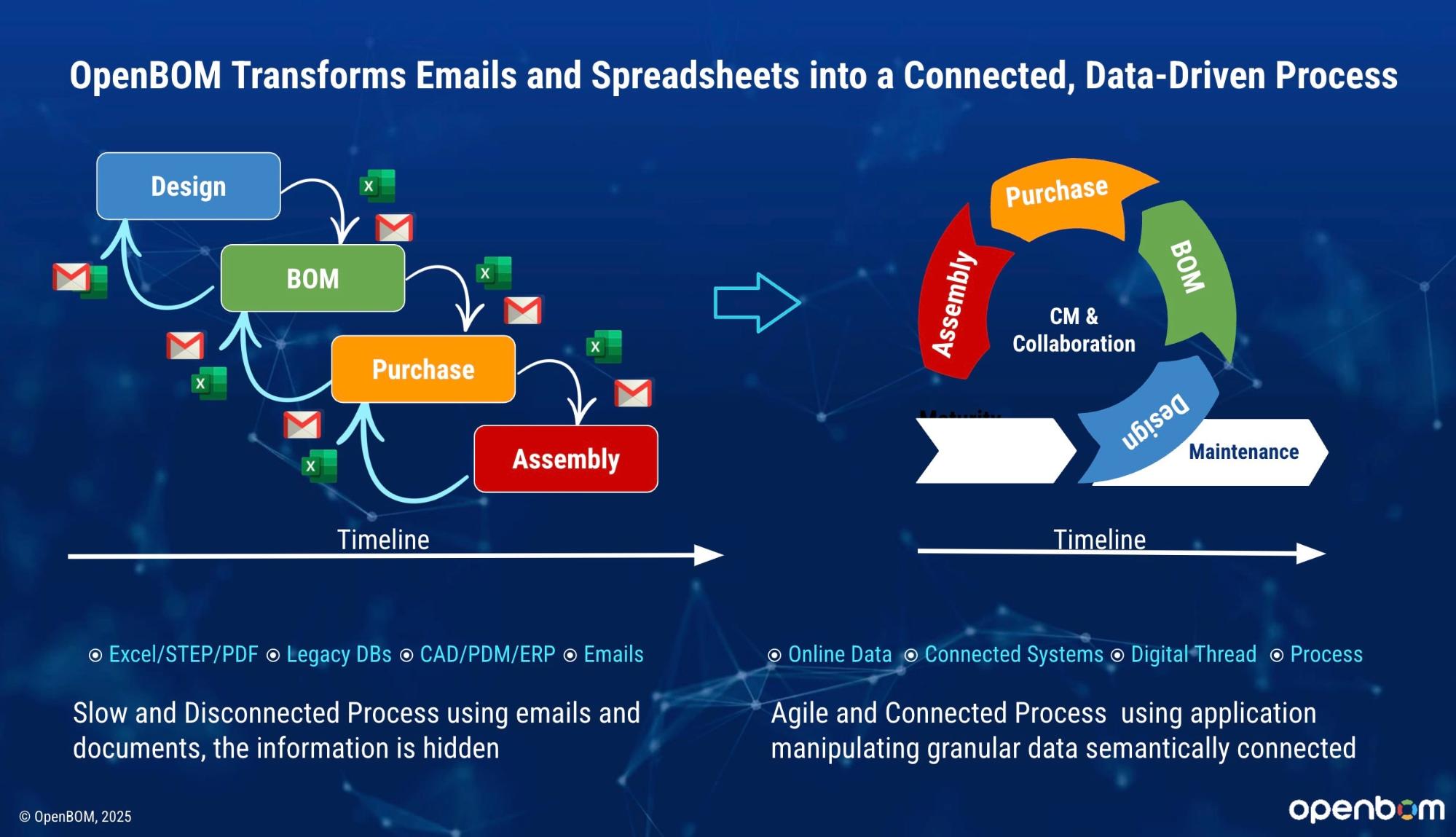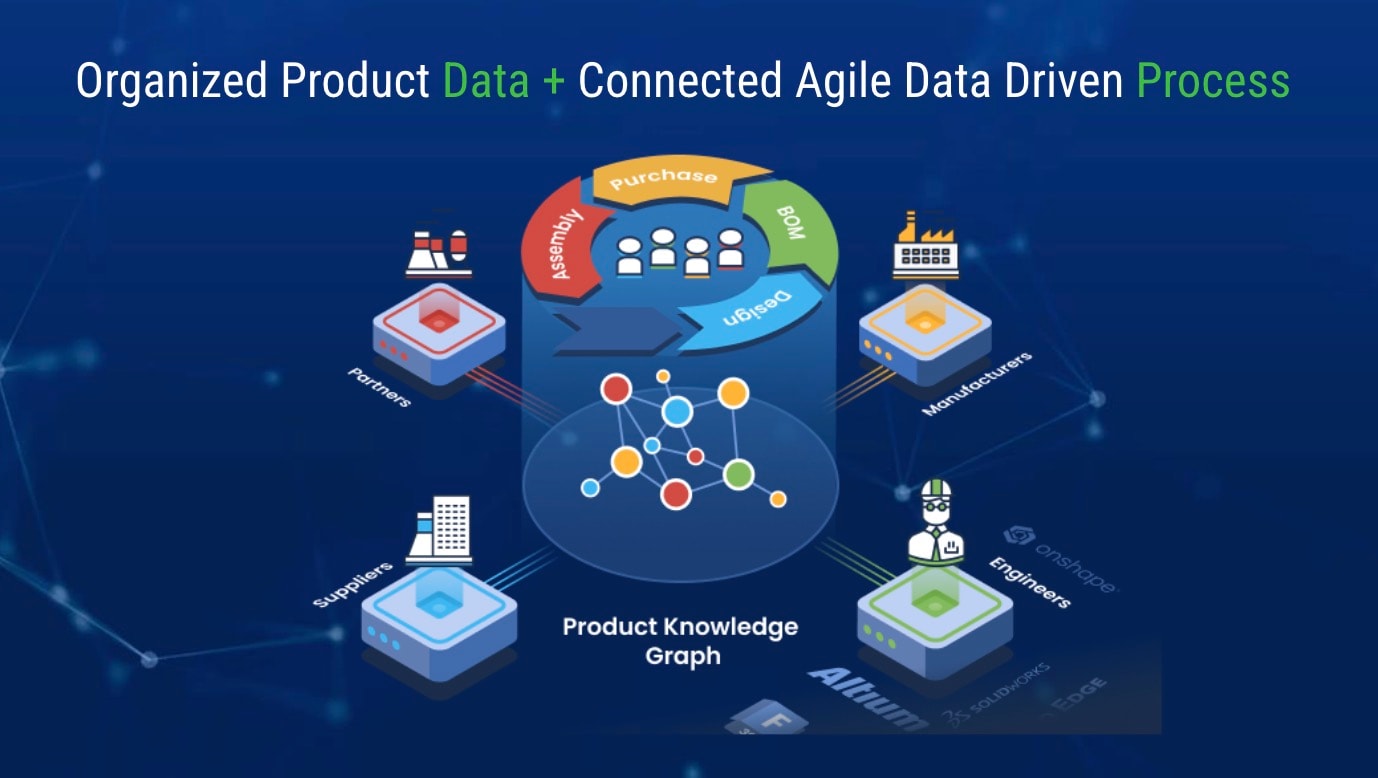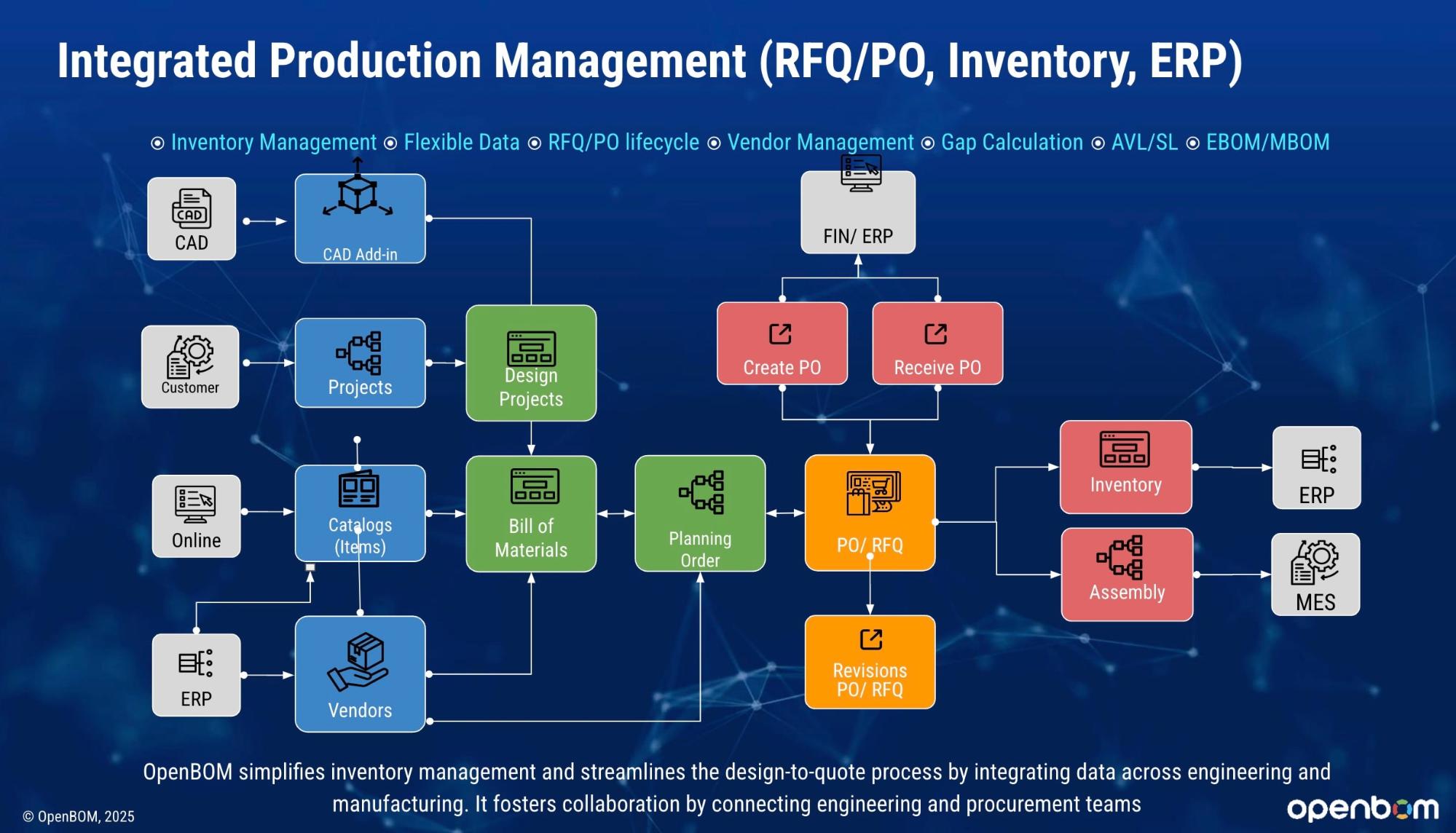In today’s manufacturing world it’s no longer enough to design a product and toss the CAD file over the wall to someone else to worry about production. That old method doesn’t work in the face of global supply chain pressure, rapid prototyping cycles, and the demand for cost visibility earlier in the process. Instead, what’s needed is a tight, integrated workflow that brings engineering and procurement together from day one.
That’s exactly the philosophy behind OpenBOM’s approach to product planning—a fresh, agile way to manage new product development (NPD) by breaking down the silos between design, purchasing, and production. In this article, I’ll guide you through how OpenBOM supports this transformation by integrating five essential elements of product planning: item definitions, vendor and supplier data, engineering BOMs, procurement tools (orders, RFQs, and POs), and inventory control and release to production. These elements work together within OpenBOM’s unique cloud-native environment to give teams real-time visibility and control over their product lifecycle—from the first sketch to the production floor.
Let’s take a closer look at each of these core elements and how they fit into the broader agile NPD workflow OpenBOM supports.

OpenBOM Production Planning- What is it?
The goal of the OpenBOM production planning and purchasing process is to provide a mechanism to manage the inventory of all of a company’s items. This mechanism allows manufacturing companies to perform the planning of their capacity needs required to manufacture a specific product in a quantity that is needed for a specific sales order.
Production planning includes the following mechanism to support production process and procurement planning such as inventory management (organized via “Catalog Quantity on Hand”), Vendor management (allows you to manage lists of vendors and suppliers), RFQ and order management (planning BOM for purchase planning); RFQ and POs (create and receive), and the last important function release to production to final assembly, consumptions of all components and assemblies and updating inventor (decreasing quantity on hands)
Production planning is seamlessly integrated with BOM functionality in OpenBOM allowing seamless integration of processes and smooth data handover between engineering and purchasing departments.

Why do you need production planning?
Modern manufacturing and production processes demand quick planning and tight connection between engineering and production. Without such integration, it is hard to build products on time and at the right price. The time when “throwing design over the wall of manufacturing” was the main method is gone.
These days, engineering teams, startups and manufacturers are looking for an efficient way to establish production planning, including procurement of correct components and parts to have an earlier insight on product cost, availability of components and production capacities. OpenBOM production and procurement planning is the tool that allows manufacturing companies, prototyping teams and hardware startups to work in an agile and data-driven environment.
From Isolated Workflows to Agile Product Planning
Before we explore the details, it’s important to understand the problem OpenBOM solves.
In typical engineering and manufacturing software, the production planning (MRP) function is isolated from engineering functions. Production planning software and production scheduling are separate from engineering definitions and a handoff between these functions is extremely complex, requiring manual re-entry of information from engineering (PDM/PLM) functions to production planning functions to create master production schedule and perform procurement of components and outsource supplier work. While sophisticated production scheduling software and production management can be very sophisticated the disconnect between these functions is extremely painful for successful manufacturing business. The question about how to improve production performance and production control was one of the key element of OpenBOM agile production planning methods.
In many companies, engineering and manufacturing operate with disconnected tools and processes. Engineers work in CAD and export BOMs to Excel, while procurement builds supplier lists and generates purchase orders in spreadsheets or ERPs that aren’t linked back to design. This fragmentation causes delays, miscommunication, and errors.
OpenBOM replaces this chaos with a unified flow of information that spans four critical stages: design, bill of materials, procurement, and assembly. It does this through a collaborative, real-time platform where changes made by one team are visible to others immediately. This is the foundation of agile NPD—a way to iterate quickly, estimate costs early, adapt to change, and deliver on time.
The First Element: Item Definitions
Every great product begins with a solid understanding of the items it’s made of. In OpenBOM, item definitions form the foundation of product planning. These are not just placeholders for part numbers, but rich, structured representations of everything that will be used or assembled. Items can include mechanical parts, electronic components, sub-assemblies, raw materials, or even services and labor.
Each item is stored in a catalog—a centralized, editable repository of product data. These catalogs contain all relevant information such as part numbers, units of measure, costs, manufacturer part numbers, and additional custom properties. What’s powerful about OpenBOM is that these catalogs are not static. They are living documents, shared and updated in real time, which means everyone—from engineering to procurement—works from the same source of truth.
This level of clarity and centralization eliminates common mistakes like duplications, outdated cost estimates, or incomplete data during procurement. And since items are reused across BOMs and revisions, OpenBOM makes it easy to maintain consistency across multiple projects and assemblies.
Vendors and Suppliers: A Seamless Extension of Item Data
Once items are defined, the next step is knowing where they come from. OpenBOM allows users to attach vendor and supplier information directly to each item in a way that’s tightly integrated and easily accessible. This includes the supplier name, vendor-specific part number, cost per unit, lead time, and purchasing conditions such as minimum order quantities.
This connection between items and suppliers ensures that procurement decisions are grounded in the latest design and engineering data. If an engineer updates a part or changes the required quantity, procurement teams see the change instantly and can adapt purchasing plans accordingly.
This built-in vendor management becomes even more valuable during planning, especially when alternate or substitute vendors are needed due to lead time issues or availability. Instead of managing vendors in external spreadsheets or legacy ERP systems, OpenBOM keeps all vendor relationships and data tied to the item catalog and BOMs—creating a single environment where sourcing decisions are informed and traceable.
Engineering BOM: The Central Thread of Product Planning
The Engineering Bill of Materials (EBOM) is where the rubber meets the road. It’s the structured list of components that defines the product, and in OpenBOM, it’s a living, dynamic structure linked directly to item definitions and catalogs.
As engineers create assemblies in their CAD system, OpenBOM plugins allow them to automatically generate BOMs with one click—no exporting, no spreadsheets. These BOMs are multi-level, meaning they can reflect complex product hierarchies with nested subassemblies and referenced items. The BOM isn’t just a list of parts—it also tracks quantities, usage, reference designators, and other attributes.
One of the most critical aspects of OpenBOM’s EBOM is its ability to stay synchronized with the design. As designs evolve, BOMs update, and those changes ripple through the entire planning process. That means procurement and manufacturing are always working with the latest data, enabling true concurrent engineering.
In practice, this means a design update doesn’t require a separate communication process to purchasing—it’s already there. The BOM acts as the digital thread connecting design intent to purchasing execution.
Smart Procurement: Orders, RFQs, and Purchase Orders
With the BOM in place and vendors assigned, it’s time to figure out what needs to be purchased, in what quantity, and from whom. OpenBOM includes powerful tools for procurement planning and execution that make this step straightforward.
At the heart of this is the Order BOM—a specialized view of the standard BOM used for procurement. The Order BOM automatically aggregates required quantities based on the build quantity, factoring in sub-assemblies and multi-level relationships. With this structure, procurement managers can easily calculate what’s needed to fulfill a production run or prototype build.
Once the Order BOM is prepared, OpenBOM enables users to generate RFQs and POs directly from the data. A user can select the vendor, generate a purchase order document, and even email it directly from within the system. When the ordered items arrive, OpenBOM lets you mark them as received—fully or partially—and updates inventory levels accordingly.
This level of automation reduces errors, eliminates manual data re-entry, and ensures that procurement activity aligns tightly with engineering designs and actual production needs.
Inventory Control and Releasing to Production
The final piece of the product planning puzzle is managing inventory and transitioning from planning to actual production.
In OpenBOM, each item in the catalog also includes a quantity-on-hand value that updates in real-time based on received POs and consumed parts. This allows you to monitor what you actually have in stock, which parts are on order, and when you’ll be ready to begin assembly.
This inventory awareness is critical for batch-based production planning. If a team plans to build 100 units, OpenBOM can immediately calculate whether enough materials are available—or if more need to be ordered. It also allows you to model partial builds, plan replenishment cycles, and minimize over-ordering.
Release to production is no longer a moment of confusion or fire drills. With OpenBOM, it becomes a data-driven decision based on up-to-date inventory and order tracking, directly connected to the original design and product structure.
A Unified Interface: Data, Not Documents
One of the most important advantages of OpenBOM is its user interface. Unlike traditional PLM or ERP systems that are often cumbersome and locked behind complex IT infrastructures, OpenBOM offers a simple, modern, spreadsheet-like UI that works in the browser.
This familiarity lowers the barrier to entry and shortens onboarding time for engineers, purchasers, and operations teams. Everyone sees what they need—items, BOMs, vendors, orders, and inventory—in a single, unified workspace.
And with full support for CAD integrations (SolidWorks, Fusion 360, Altium, and others), OpenBOM becomes the central platform where engineering output flows seamlessly into procurement and production planning, without requiring custom scripts or middleware.
The clean user experience, combined with real-time collaboration, permissions, and revision control, makes OpenBOM an accessible yet powerful system for any organization focused on improving its product development lifecycle.
Why is OpenBOM different?
A typical production planning software is disconnected from the engineering process.Typically implemented for large companies, the production process is isolated and data is synchronized between ERP and PLM systems. While this is how traditional systems work, OpenBOM offers a different integrated production and procurement planning process where engineering definition (EBOM) is tightly connected to procurement and production planning (Order).
The following diagram shows how OpenBOM business processes work from CAD design to engineering BOM and later to purchase orders and inventory control. A unique element of the solution is seamless integration and simplicity of inventory and purchasing functions.

To succeed in today’s product-driven economy, companies must bring engineering and procurement together. Designs should inform procurement, and procurement constraints should inform design. OpenBOM offers the infrastructure and toolset to make this a reality.
The five core pillars—item definitions, supplier management, EBOM, procurement tools, and inventory control—form the foundation of OpenBOM’s product planning capabilities. Together, they eliminate guesswork, reduce time-to-market, and support a lean, agile approach to hardware development.
OpenBOM is fundamentally different from legacy PLM or ERP systems because it is built on a modern, cloud-native architecture that enables real-time collaboration and flexibility across distributed teams. Integrated agile new product development is no longer a luxury—it’s a necessity. For small and medium-sized manufacturing companies, the ability to iterate quickly, respond to supply chain changes, and maintain accurate product data in one connected system is mission-critical. For large enterprise NPD teams, it enables innovation at scale while reducing friction between silos. OpenBOM connects the dots and accelerates innovation from concept to delivery.
Whether you’re a startup building your first prototype or a small manufacturer scaling production, OpenBOM gives you the visibility and control to build better products, faster.
The era of “throwing designs over the wall” is over. With OpenBOM, engineering and manufacturing can finally work as one team—planning, building, and growing together.
❓ OpenBOM Production Planning – F.A.Q.
What is OpenBOM Production Planning?
It’s a cloud-native solution that connects engineering, procurement, and inventory management into a single, real-time workflow. OpenBOM helps teams manage product data from design through purchasing and into production.
Why do manufacturers need it?
The old approach of throwing CAD files over the wall to manufacturing doesn’t work anymore. Today’s fast-paced production cycles require tight integration between engineering and procurement. OpenBOM replaces disconnected spreadsheets and siloed systems with an agile, collaborative process.
What does it offer?
OpenBOM provides live item catalogs with vendor and supplier data, multi-level engineering BOMs, tools for creating RFQs and purchase orders, real-time inventory tracking, and smooth release to production—all in one place.
How does it work with CAD tools?
OpenBOM integrates directly with CAD systems like SolidWorks and Fusion 360, enabling users to generate and update BOMs in real time without exporting or re-entering data.
What sets it apart?
Unlike traditional PLM or ERP systems, OpenBOM is lightweight, easy to adopt, and built for real-time collaboration. It eliminates manual handoffs and keeps all stakeholders aligned.
Who is it for?
Whether you’re a startup building prototypes or a growing manufacturer scaling operations, OpenBOM gives your team the visibility and control needed to develop and deliver products faster.
